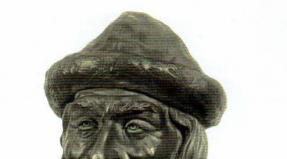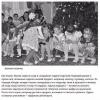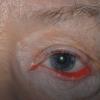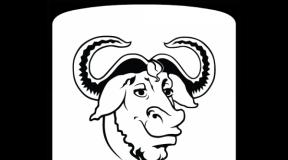Non-systemic dizziness symptoms and treatment. Dizziness: causes, methods of diagnosis and treatment. Mechanisms for maintaining balance
Dizziness (or scientifically vertigo) is a symptom that manifests itself as a sensation of rotation of surrounding objects around the patient, or vice versa, as the rotation of the person himself around its axis. Almost never this symptom is isolated, it is usually accompanied by other manifestations of trouble in the body. There are a number of pathological conditions in which dizziness occurs, and often it is possible to identify them only after a serious examination.
Balance regulation system
Several organs are involved in the regulation of balance:
- visual analyzer;
- vestibular apparatus;
- proprioceptive apparatus;
- brain structures.
visual analyzer
A person sees the surrounding objects and, based on the information received, can be aware of his position in space. It is no coincidence that in pitch darkness sometimes there is instability in vertical position.
Located in the skull in the cavity inner ear. Anatomically compatible with the auditory analyzer. It consists of three hollow tubes (semicircular canals) located at an angle to each other, lined from the inside with a special shell with a mass of receptors and filled with liquid. When you change the position of the body (or rather, the head) in space, the fluid shifts, irritating the receptors. The transmission of information from them is carried out through the vestibular nerve, which sends impulses to intracerebral structures.

Proprioceptive (somatosensory) system
All organs, muscles, ligaments and bones of the body are permeated with millions of nerve endings. Some of them are equipped with sensitive receptors, from which the brain receives information about changes in body position. Evidence of this is the inability to maintain balance when the nerves of the limbs are damaged.
intracerebral structures
The main center of balance is located in the cerebellum. However, there are several more structures (the reticular formation, the vestibular nuclei of the brainstem and cerebellum, the extrapyramidal system) that perceive and process information coming from receptor systems. visual analyzer, vestibular apparatus and nerve endings of the body.
Dysfunction of any of the sections of this is unbelievable complex mechanism leads to a distortion of the patient's perception of their position in space, which is manifested, among other things, by dizziness.

There are two main types of dizziness:
- systemic associated with dysfunction of the vestibular apparatus at different levels; in turn is divided into:
- central - with damage to brain structures;
- peripheral - with damage to the nerve nodes, nerves, semicircular canals;
- non-systemic, which includes:
- balance disorders associated with the inconsistent action of all three systems for maintaining balance - the visual analyzer, the vestibular apparatus and the proprioceptive mechanism;
- pre-syncope, in which dizziness is caused by sharp deterioration supply of any of the elements described above;
- psychogenic dizziness that occurs with anxiety or depression.
There is a separate form of vertigo - physiological dizziness. This type of symptom is not associated with any pathology and is caused by excessive irritation of the vestibular apparatus. Seasickness is a classic example of this type of vertigo.
Features of dizziness depending on the cause
The cause of dizziness is the main factor affecting its features. The nuances of vertigo are determined by the level of damage to the balance system and the accompanying neurological symptoms that manifest themselves in the underlying disease.
30-50% of all patients complaining of vertigo suffer from its systemic form. It is caused by a number of diseases:

At Meniere's disease along with recurring attacks of dizziness, tinnitus, periodic hearing loss, pronounced autonomic disorders are noted. Vertigo lasts from several minutes to a day, the frequency of attacks is very diverse - from once a year to several times a day. Often, before an attack, there are sensations of stuffy ears, a feeling of heaviness, noise in the head, and impaired coordination of movements.
Vestibular neuronitis- inflammation of the vestibular nerve, in which the most striking symptom is intense dizziness for several hours. This pathology occurs acutely, due to infectious causes or intoxication. Vestibular neuronitis is characterized by the complete absence of focal neurological and meningeal symptoms and the complete preservation of hearing.
BPPV- a syndrome that occurs when calcium crystals form in the semicircular canals. A change in the position of the head causes their displacement and strong irritation of the receptors of the vestibular apparatus. At the same time, an attack of sweating occurs, the pulse rate decreases. Auditory phenomena (noise, hearing loss) and neurological symptoms are absent.
Tumors cerebellum, brainstem and paracerebellar region often present with vertigo. This symptom may be the only sign of a volumetric process in the brain for a long time.
Dizziness that occurs immediately after a TBI, usually indicates injury to the labyrinth. Meningeal, focal symptoms are absent, but there is a pronounced headache often nausea and vomiting. Sometimes vertigo appears only a few days after the injury, and then one can suspect the development of inflammation of the labyrinth - serous labyrinthitis.
The use of aminoglycoside antibiotics often provokes toxic damage to the auditory and vestibular apparatus. Thus, gentamicin primarily damages the structures of the labyrinth. Such damage is almost always irreversible.
Vertebrobasilar insufficiency- This is a disease in which there is a deterioration in the blood supply to both the labyrinth and intracerebral structures. Simultaneously with dizziness, other neurological symptoms are also detected: motor and sensory disorders associated with damage to the nuclei of the cranial nerves, visual disturbances, and coordination disorders. The cause of this condition can be osteochondrosis, atherosclerosis, anomalies in the development of the main and vertebral arteries, that is, any conditions leading to a decrease in the lumen of these vessels.
Attack dizziness with migraine is not a symptom of the disease, but one of the types of aura - a condition that precedes the onset of headaches.
In temporal lobe epilepsy, vertigo is combined with powerful autonomic symptoms:
- pain in the stomach;
- nausea;
- sweating;
- increased salivation;
- slowing down of the pulse.
This form of epilepsy is not accompanied by seizures, but other sensory disturbances, such as visual hallucinations, may occur.
Encephalitis- most often viral inflammation of the brain, which begins acutely or subacutely, followed by stabilization of the condition or gradual regression (subsidence) of symptoms. Vertigo is accompanied by other, very diverse neurological symptoms.
 Vertigo is often seen in multiple sclerosis
. The characteristic course of the pathology, the multifocal lesion, and the results of instrumental and laboratory studies make it possible to clearly determine the presence of the underlying disease. Difficulties can arise only then. When other symptoms are mild or dizziness is the very first sign of multiple sclerosis.
Vertigo is often seen in multiple sclerosis
. The characteristic course of the pathology, the multifocal lesion, and the results of instrumental and laboratory studies make it possible to clearly determine the presence of the underlying disease. Difficulties can arise only then. When other symptoms are mild or dizziness is the very first sign of multiple sclerosis.
At anomalies in the development of the cervical vertebrae and the base of the skull, dizziness is caused by a mechanism similar to vertebrobasilar insufficiency. Usually there are other symptoms of the underlying disease, on the basis of which the final diagnosis is made.
Non-systemic dizziness
This includes types of dizziness that are not directly related to the work of the vestibular analyzer.
Balance disorders that occur when the three systems that regulate the position of the body are not coordinated can be the result of:
- dysfunction of the vestibular system without damage to the semicircular canals; while the patient, closing his eyes, loses the ability to maintain balance;
- lesions of the cerebellum, in which visual control does not affect the severity of symptoms;
- lesions of the subcortical nerve centers;
- disturbances in the transmission of impulses from the visual analyzer, proprioreceptors;
- taking certain medications that affect nerve conduction.
In a pre-fainting state, dizziness is often accompanied by a feeling of dizziness, noise or ringing in the ears, unsteadiness, loss of balance, "blackout in the eyes." Emotional disorders are also noted - fear, anxiety, impotence, depression. Often, after the onset of these symptoms, fainting occurs, but it happens that they gradually disappear without losing consciousness to the patient.
Psychogenic dizziness most often occurs with hysteria, as well as with some phobias (fear of open spaces). This type of vertigo is characterized by great persistence, pronounced emotional perception.
Treatment
Treatment of dizziness is carried out according to the rules adopted for the treatment of the underlying disease:
- when used, vasodilators, antiplatelet drugs;
- with Meniere's disease, salt intake is limited, diuretics are used, and, if necessary, surgical intervention is performed;
- vestibular neuronitis is treated with;
- benign paroxysmal positional vertigo is treated mostly non-pharmacologically; there are a number of techniques that allow you to move calcium crystals to the area of \u200b\u200bthe vestibule of the labyrinth, where they will not irritate the receptors;
- in epilepsy, special agents are used that suppress excessive electrical activity of the pathological focus in the brain.
Apply and symptomatic remedies, allowing to interrupt the flow of impulses from the vestibular receptors (betahistine).

In some forms of dizziness, the use of meclozine, promethazine, cinnarizine is indicated. Sedative drugs are widely used, which do not eliminate dizziness, but make it easier to endure it.
Treatment of psychogenic dizziness is carried out by prescribing psychotropic drugs - antidepressants, tranquilizers, and sometimes - anticonvulsants with a sedative effect. Psychotherapy is also very effective, since vertigo in this case is not organic in nature, but rather is a feature of the perception of the surrounding reality.
Dizziness is just one of many neurological symptoms. Its appearance clearly indicates trouble in the body. That is why, with repeated attacks of vertigo, it is necessary to consult a doctor as soon as possible for examination and quality treatment.
First, it is worth understanding what doctors mean by dizziness. This is an illusion of feeling the environment around or oneself around the space. Everyone has experienced such a feeling after a long ride on the carousels. But some mean by this symptom unsteadiness when walking, pre-fainting, heaviness inside the head, a feeling of dizziness, swaying.
There is confusion with terms in Russian literature. In some sources, you can find the concept of "vertigo", borrowed from in English. It is used to denote the illusion of rotation. And "dizziness" is used as a collective term for all other complaints. It's probably more logical that way. In this article, the collective concept of "dizziness" and the term "vertigo" will also be used.
Other causes of vestibular vertigo
Non-systemic dizziness is a very non-specific symptom. It can be a manifestation of almost any pathology of the body. This article will discuss the most common diseases, which include:
- Hypertension - persistent increase blood pressure.
- Chronic debilitating diseases - oncology, heart failure, impaired liver or kidney function.
- Anemia is a decrease in the level of hemoglobin and oxygen in the blood.
- Acute or chronic bleeding.
- Hypoproteinemia - a decrease in the level of protein in the blood in diseases of the liver or kidneys.
- Dehydration - dehydration of the body intestinal infections, blood loss.
- Vegetovascular dystonia (VVD) - dysfunction of the vegetative department nervous system.
An attack can cause any sudden drop in blood pressure. Often, people experience this symptom when it is reduced. There is a syndrome called orthostatic hypotension. The main manifestation is a sharp decrease in pressure after the transition from a horizontal to a vertical position. Many have experienced it more than once after getting out of bed quickly. For a few seconds, there is an impression that a loss of consciousness is about to occur. This is an attack of non-systemic dizziness.
As already mentioned, about 70% of all cases of vestibular systemic vertigo are associated with DPG. In other cases, the reasons may be completely different:
- vertebrobasilar insufficiency is a cause characteristic mainly for the elderly category of people. It develops against the background of vasculitis, atherosclerosis of the basilar or subclavian artery, cardiogenic embolism, etc. Severe vertigo is accompanied by vomiting and discoordination. It develops due to coronary disease vestibular nerve or trunk. With ischemia of the adjacent stem sections, a violation of visual function, doubling of the visual picture is possible. Aspirin is often prescribed to relieve symptoms of the disease;
- vestibular neuritis is a disease in which the vestibular nerve or peripheral vestibular apparatus is affected. To the main symptom of vertigo - a sensation of rotation in space, is added severe vomiting, as well as nystagmus with a fast phase, directed exclusively in one direction: from the diseased ear to the healthy one. The patient experiences discomfort with every movement of the head, and in order to avoid it, he may even constantly support his head. If hearing impairment is added to the symptoms, then this is not neuritis, but labyrinthitis. Usually, neuritis is treated in a couple of weeks, otherwise the doctor may suspect Meniere's disease in the patient. If after a month the neuritis has not been cured, you need to undergo an MRI, CT scan and an audiometry procedure. Among the drugs that facilitate the course of the disease are corticosteroids. Their use should be limited exclusively to the exacerbation phase, and then canceled, replacing it with the usual vestibular gymnastics (controlled rotation of the eyeballs in different positions: lying, standing, walking, etc. help the patient reconfigure his vestibular apparatus and get rid of the disease);
- Meniere's disease can be distinguished by the following important symptoms: tinnitus, feeling of congestion, hearing loss, episodic vertigo. The acute phase of the attack lasts for several minutes, after which it subsides, gradually subsiding. After each subsequent attack, hearing becomes worse. This process is reversible only with appropriate treatment of the disease on early stage;
- chronic vestibulopathy is characterized by a slow increase in symptoms. So, vertigo appears only at 3, 3.5 weeks of treatment of the disease. Most often, the disease is associated with intoxication from taking ototoxic drugs;
- blockage of the external auditory artery is the most dangerous possible cause of dizziness. The disease can be a manifestation of a heart attack in the cerebellum. If you do not help the patient in time, the most likely outcome is death. This disease is especially dangerous due to the similarity of early symptoms with neuritis. It is possible to distinguish a cerebellar stroke by such signs as: bilateral nystagmus (with neuritis it is exclusively one-sided), the patient's inability to stand on his own (even with his eyes open);
- dizziness after injury (fracture temporal bone, concussion of the labyrinth, the formation of perilymphatic fistulas) or ear diseases: Eustachian tube dysfunction, sulfur plugs, otitis media, otosclerosis;
- basilar migraine- a disease characteristic mainly for adolescent girls. Discomfort is reduced by the use of triptans and aspirin. Beta-blockers and tricyclic antidepressants are prescribed to avoid recurrent attacks.
The most rare causes of vestibular vertigo are:
- tumor of the cerebellopontine angle,
- epilepsy,
- craniovertebral anomaly.
Most likely, DPG will be detected, however, in order to avoid unpleasant consequences, it is better to take a blood test, an electrocardiogram and an x-ray of the cervical spine, and undergo a complete examination of the vestibular system (audiometry, electrocochleography and MRI) in order to exclude other diseases and pathologies. An important aspect of the treatment and further prevention of vestibular vertigo is gymnastics.
Such a disorder of the vestibular apparatus as vestibular vertigo is a condition in which a person feels an imaginary rotation of objects and space around him or an imaginary rotation of his own body.
Such attacks are episodic, they are provoked by changes in head positions, energetic movements: rotation, dancing, rocking. The most striking example of this disorder is dizziness after a carousel or intolerance to riding in vehicles.
Vestibular vertigo can have different strength and intensity: from mild discomfort to loss of consciousness. At the same time, even an attack with minimal intensity can significantly affect a person’s performance, and, repeating from time to time, even provoke the development of diseases of the nervous system.
Vestibular vertigo is characterized by patients as a sensation of rocking, rotation, falling of the surrounding space, objects, as well as their own body. The cause of this disorder is a violation of the vestibular analyzer.
Such a disorder is systemic in nature, it disrupts the work of many important systems in the body: vestibular, visual, muscular.
Systemic and non-systemic dizziness associated with disruption of the vestibular analyzer may occur for various reasons. Thus, central vertigo is caused by malfunctions of the brain, peripheral vertigo is caused by a malfunction of the middle ear or nerve, and the cause of physiological vertigo is normal fatigue, fatigue, severe stress or prolonged malnutrition.
The causes of vestibular episodic systemic vertigo can be a variety of lesions of the central and peripheral sections. If the seizures are persistent, the reason for their appearance may be:
- infectious and traumatic injuries of the vestibular fibers;
- the use of drugs that have a toxic effect on the receptors of the vestibular apparatus.
Symptoms of the disease
The main symptoms of the disease are the sensation of rotation of objects around or one's own body, as well as the fluctuations of the eyeballs, often made in time with the rotation.
In addition, a person may experience the following auxiliary symptoms:
- nausea or vomiting;
- inflow or sharp outflow of blood from integuments;
- uncoordinated movements;
- increase or decrease in blood pressure;
- profuse sweating.
It should be borne in mind that if these symptoms occur on their own, and not as an addition to the main symptoms of vertigo, this may be a sign of a more serious disease.
Often, various variations of pre-syncope conditions are taken for the symptoms of this disease, accompanied by darkening in the eyes, sweating, nausea, rapid heartbeat, a feeling of detachment and emptiness in the head. This condition indicates the presence of pathology in the patient's body (anemia, hypoglycemia, various lesions of the components of cardio-vascular system), which can only be determined with a complete examination.
Not included among the symptoms of a disorder of the vestibular apparatus and a variety of imbalances (staggering, instability) caused by organic lesions of the nervous system: myelopathy, polyneuropathy, parkinsonism, and so on.
Cause more than 70-80% of cases of complaints of vertigo in clinical practice is benign paroxysmal positional vertigo. It does not last long: from a few seconds to a couple of minutes, does not harm a person, and occurs only with sudden changes in the positions of the body and head in space. Additional examinations and specific treatment for its diagnosis are not prescribed.
BPPV can occur regardless of age or gender. It develops due to the accumulation of otoliths in the region of the receptors of the inner ear - small crystals that freely move through the ear cavity. Under the influence of gravity, the otoliths are shifted to the receptors, and thereby provoke vertigo.
BPPV is characterized by its same type clinical picture: the patient complains of sharp attacks of vertigo that appear immediately after changing the position of the body, tilting the head back, tilting, getting up from a horizontal position.
Diagnosing BPPV is simple, it is enough to conduct several positional tests: vertigo and nystagmus appear immediately after a change in disposition.
Vertigo can persist for years and even decades in an unchanged state, without the addition of other symptoms. After some time, a period of remission may begin, which can also last up to ten years, or may be replaced by an exacerbation after a few months. It is difficult to identify any patterns in the nature of the course of the disease.
Symptom types
There are several types of dizziness. Each of them has its own reasons. And the choice of method of diagnosis and treatment directly depends on the reasons. The following types of this symptom are distinguished:
- Non-systemic - characteristic of diseases not associated with damage to the nervous system (pathologies of the heart and blood vessels, hormonal imbalance, blood diseases).
- Systemic - develops as a result of dysfunction of the vestibular system, including brain structures.
- Psychogenic - typical for people with mental neurotic disorders.
- Mixed - various factors take part in the development of the symptom, it is difficult to find out the cause.
Symptoms
An attack of non-systemic dizziness is accompanied by increasing fatigue, general weakness. The patient may darken in the eyes, there will be ringing or noise in the ears. Sometimes hearing is reduced or, conversely, sensitivity to sounds increases. In the medical literature, this condition can be found under the name "hyperacusis".
Symptoms of concomitant activation of the autonomic nervous system are characteristic. With an intense or prolonged attack, a person feels sick. There may be occasional vomiting. The skin turns pale, there is profuse sweating. There is a feeling of unreasonable fear of death, anxiety.
There is a separate type of non-systemic dizziness - imbalance and gait. This group of diseases includes paresis (weakness of the limbs) in stroke, shuffling gait in Parkinson's disease, sideways deviance and unsteadiness in diseases of the cerebellum. Patients can describe all these conditions in one word - dizziness.
To effectively treat non-systemic dizziness, it is necessary to accurately understand the cause of its development. The therapy includes the following aspects:
- Symptomatic treatment - elimination of the attack.
- Etiotropic treatment - the impact on the cause.
- Pathogenetic treatment- influence on the mechanisms of occurrence of the symptom.
To reduce the severity of an unpleasant symptom, Betaserc, psychogenic dizziness, Clonazepam, are used. For the same purposes, drugs are used that improve metabolism in the cells of the nervous system: Cavinton, Piracetam. Often in patients there is a decrease in the tone of the venous wall. Effective for its increase "Troxevasin", "Detralex".
Attacks of mild non-systemic dizziness can be stopped by means traditional medicine. Effective infusions of herbs motherwort, wild rose. Take a decoction of one cup three times a day.
Sometimes, to get rid of an unpleasant symptom, it is enough to breathe fresh air. To reduce the frequency of seizures, aerobic exercise will help: jogging, walking, morning exercises.
The most important thing in dealing with a symptom is to eliminate the cause. The choice of drug directly depends on the underlying disease. In the presence of hypertension, drugs that reduce blood pressure are prescribed: Enalapril, Nifedipine, Propranolol. If dizziness is caused by heart pathology, antiplatelet agents ("Acetylsalicylic acid"), "Nitroglycerin", antiarrhythmic drugs ("Cordarone") are used.
Non-systemic or, as they are also called, pseudo-vertigo are observed much more often than systemic ones and can be different types.
Basic diagnostic methods
Diagnosis of diseases manifested by non-systemic dizziness should be comprehensive. Other symptoms of the disease should be assessed. For example, hypoproteinemia is characterized by swelling on the face, in the upper body. Attacks of high blood pressure are accompanied by a headache, flickering flies before the eyes.
Since there are many diagnoses under non-systemic dizziness, it may be necessary to consult various specialists: a neurologist, a cardiologist, a hematologist, an endocrinologist, an infectious disease specialist. After a thorough conversation and examination of the patient, additional methods examinations. The following diagnostic methods will help in determining the cause:
- Measurement of blood pressure - to find a connection between its changes and the appearance of a symptom.
- General analysis blood to exclude the presence inflammatory processes in organism.
- Complete urinalysis - excludes infection of the genitourinary system.
- Magnetic resonance or computed tomography of the brain - allows you to exclude organic lesion central nervous system.
- Electrocardiogram, echocardiogram (ultrasound of the heart) - detection of cardiac pathology.
To diagnose dizziness and determine its causes, a number of studies are carried out. To begin with, the patient should describe a typical attack. When collecting an anamnesis, the doctor should find out the duration of dizziness, the relationship with a change in body position, the presence of nausea, vomiting, and other associated symptoms.
An important diagnostic criterion is also the presence of nystagmus - this condition consists in the involuntary oscillation of the eyeballs. This problem may be due to a change in the position of the head.
An otolaryngologist may perform special temperature tests. In this case, the ear canal is irrigated with water, the temperature of which differs by seven degrees from the temperature of the blood up or down. Such studies can provoke nystagmus and a sense of rotation of the body.
The doctor may also perform rotational testing. In this case, the person is rotated on a special chair and the movements of the eyeballs are recorded.
Recently, the study of the tracking function of the eyes, which is carried out in the presence and absence of visual interference, has begun to be used. The prospect of this testing is associated with the close interaction of the vestibular and visual systems.
Treatment of non-systemic dizziness
For treatment of non-systemic vertigo to be effective, it must include medication and non-pharmacology. In any case, first of all, you need to establish the cause of the development of this condition.
To relieve anxiety, tranquilizers - diazepam or lorazepam - can be prescribed. Sedatives are also actively used - andaxin, seduxen. In some cases, the use of vascular and anti-inflammatory drugs is required.
In case of disruption of the vestibular apparatus, special training is very useful. There are certain sets of exercises that allow people to learn how to control dizziness.
Separately, it is worth mentioning betahistine - it is a synthetic drug that resembles H1 and H3 histamine receptors, which are located in the inner ear and vestibular nuclei of the central nervous system. The drug helps to improve microcirculation and capillary permeability. It also normalizes the pressure of the endolymph.
Betahistine improves blood circulation in the basilar arteries and has a pronounced central effect, since it is an inhibitor of the H3 receptors of the vestibular apparatus.
The effectiveness of the drug is evidenced by a decrease in the frequency and intensity of dizziness, a decrease in tinnitus, as well as an improvement in hearing, if there is a decrease. There is evidence of the effect of betahistine on venous outflow in the cranium.
Thanks to this, it is possible to reduce the severity of dizziness. The greatest effect was achieved in people who suffered from dizziness of psychogenic etiology.
According to the results of the research, it was found that the use of this tool helps to significantly reduce psycho-vegetative disorders and significantly improve the quality of human life.
If dizziness occurs constantly, you should immediately consult a doctor. After all, this condition may indicate the development dangerous disease which poses a real threat to life.
Non-systemic dizziness is a rather serious disorder that worsens the quality of life of a person and is accompanied by a number of unpleasant symptoms.
It is manifested by severe subjective sensations (staggering when walking, a feeling of rotation, turning over, capsizing). It seems to patients that "the wave hits the head", objects float before the eyes, the legs become entangled, the earth becomes wadded, etc. Concomitant symptoms may also be noted, but they are less pronounced.
In the presence of vestibular G. of any kind, it is necessary to resolve the issue of what level of damage to the vestibular system it is associated with. Distinguish G. caused by the pathology of the inner and middle ear (lesion of the labyrinth, root, vestibulocochlear nerve) with intact brain. It is manifested by systemic G., which is usually paroxysmal and has a pronounced rotational character; accompanied by spontaneous nystagmus, vegetative reactions (decrease in blood pressure and pulse, increased respiration, cold sweat, nausea, vomiting). In these cases, there is often hearing loss. At change of position of the head G. and the nystagmus amplify. The intervals between attacks can be long. It occurs with labyrinthitis, vestibular neuronitis, Meniere's disease and syndrome, acute circulatory disorders in the central artery of the labyrinth, with herpetic rash in the ear area, traumatic injuries of the vestibular organ (dislocation of the stapes, fracture of the base of the skull with damage to the membranous semicircular canals, hemorrhage into the labyrinth, concussion of the labyrinth ), with exogenous toxic lesions of the labyrinth (when taking salicylates, antihelminthics, mushroom poisoning, snake bites, etc.).
Allocate G., associated with thermal exposure. It occurs when the tympanic membrane is perforated - cold air or water enters the middle ear cavity (when swimming, diving), causing a change in the circulation of the endolymph in the inner ear.
Also described is mild paroxysmal G. in children (g. episodic age), which usually occurs in early age and disappear by 5-7 years. In such cases, G.'s attacks begin suddenly, there are varying degrees of severity. With a strong G., the child falls or leans against something, with a moderate G., he runs to his mother, leans his head against her and stands motionless. Such attacks of G. have a clear periodicity (they can be predicted), are rarely combined with other symptoms (sometimes there may be nystagmus), usually last several minutes; children do well outside of seizures (asymptomatic intervals). It is assumed that they are a kind of migraine equivalents.
G. is often observed, caused by damage to the vestibular nuclei of the brain stem and overlying vestibular structures: according to subjective sensations, it can be systemic, non-systemic, and mixed. Rarely accompanied by vegetative-vascular reactions (or they are mild) and damage to the organ of hearing. When the process is localized in the region of the brainstem, G. is accompanied by spontaneous nystagmus, which intensifies or changes direction in various positions of the body. With damage to the cortical structures, nystagmus is rarely observed, it is horizontal small-sweeping and does not change with a change in body position.
Treatment depends primarily on the underlying disease. In some cases it is necessary to provide emergency care for relief of G.'s attack and accompanying vegetative-vascular disorders. The following scheme is recommended medical measures: rest, elimination of sound and light stimuli, diet with restriction of fluid intake (except in cases with frequent vomiting) and table salt, applying heating pads to the legs, and mustard plasters on the cervical-collar zone. Atropine sulfate (subcutaneously or intramuscularly, and sometimes intravenously) or platyfillin (subcutaneously) work well. With moderately pronounced G., belladonna preparations (Belloid, Bellaspon, Bellataminal), Aeron in combination with vasodilators(no-shpa, nikospan, nigeksin, nikoverin); drugs that improve cerebral circulation (cinnarizine, cavinton, sermion). With frequent vomiting, metoclopamid (cerucal, raglan), thiethylperazine (torekan) is prescribed. V complex treatment general tonic and antihistamines, neuropsychotropic drugs can be used.
Robert B. Daroff
Dizziness is a fairly common and often distressing symptom. Patients use this term to describe a variety of sensations (eg, lightness in the head, weakness, whirling, lightness of thought), although some of them do not fit this definition at all, such as blurred vision, blindness, headache, tingling, "walking on cotton legs”, etc. Moreover, some patients with gait disorders will describe their difficulties, also calling them dizziness. It is necessary to take a careful history to determine exactly which of the patients who tell the doctor that they are dizzy is actually experiencing this condition.
After excluding sensations such as blurred vision, dizziness can be either a feeling of weakness (similar to the sensations preceding fainting state), or systemic dizziness (an illusory sensation of movement of surrounding objects or the body). In other cases, none of these definitions gives an accurate description of the patient's symptoms, and only when spasticity, parkinsonism, or another cause of gait disturbance is detected on neurological examination do the main sources of complaints become clear. For clinical purposes, dizziness is divided into four categories: syncope; systemic dizziness; various mixed sensations from the head and gait disturbances.
Fainting state. Fainting (syncope) is called loss of consciousness due to ischemia of the brain stem (see Chapter 12). Before the development of true syncope, prodromal signs (feeling of weakness) are often noted, reflecting ischemia in a degree not sufficient for loss of consciousness. The sequence of symptoms is fairly uniform and includes an increasing feeling of lightness in the head, partial or complete loss of vision, and heaviness in the legs, increasing to postural unsteadiness. Symptoms increase until loss of consciousness occurs or ischemia is eliminated, for example, the patient is placed in horizontal position. True systemic vertigo almost never develops during presyncope.
The causes of fainting are described in Chap. 12 and include a decrease in cardiac output various etiologies, postural (orthostatic) hypotension, and syncope-like conditions such as vertebrobasilar insufficiency and epileptic seizures.
Systemic dizziness. Systemic vertigo is the apparent movement of surrounding objects or one's own body. Most often, it is manifested by a sensation of rapid rotation around its axis, as a rule, due to damage to the vestibular analyzer. The peripheral part of the vestibular analyzer, located in the bony labyrinth of the inner ear, consists on each side of three semicircular canals and the otolith apparatus (elliptical and spherical sacs). The semicircular canals convert angular acceleration, while the otolithic apparatus converts rectilinear acceleration and static gravitational forces, which provide a sense of head position in space. From the peripheral section, information is transmitted through the VIII pair of cranial nerves to the vestibular nuclei of the brain stem. The main projections from the vestibular nuclei go to the nuclei of the III, IV and VI cranial nerves, the spinal cord, the cerebral cortex and the cerebellum. The vestibulo-ocular reflex serves to maintain constancy of vision during head movements and depends on direct projections from the vestibular nuclei to the nucleus of the VI cranial nerve (abducens) in the bridge and through the medial longitudinal bundle to the nuclei of the III (oculomotor) and IV (trochlear) cranial nerves in the midbrain . These projections are responsible for nystagmus (repetitive movements of the eyeballs), which is an almost indispensable component of the disorder of vestibular functions. Vestibulospinal pathways help maintain a stable position of the body in space. Connections with the cerebral cortex through the thalamus provide awareness of body position and head movements. Vestibular nerves and nuclei are associated with formations of the cerebellum (mainly with a patch and a knot), which modulate the vestibulo-ocular reflex.
The vestibular analyzer is one of the three sensory systems responsible for spatial orientation and body position; the other two include the visual analyzer (from the retina to the occipital cortex) and the somatosensory system, which transmits information from the periphery from skin, joint and muscle receptors. These three stabilizing systems overlap each other sufficiently to compensate for the deficiency (partial or complete) of any of them. Dizziness can be the result of either physiological arousal or a pathological disturbance in the activity of any of these three systems.
Physiological dizziness. It develops in cases where there is a discrepancy between the three above-mentioned systems or the vestibular apparatus is subjected to unusual loads to which it has never been adapted, for example, with seasickness. The discrepancy between sensory systems explains the appearance of sensations of motion sickness when driving in a car, high-altitude dizziness, visual dizziness, most often occurring while watching movies with chase scenes, in the latter case, the visual sensation of the movement of surrounding objects is not accompanied by the corresponding vestibular and somatosensory motor signals. Another example of physiological dizziness is space sickness caused by the active movement of the head in zero gravity.
Pathological dizziness. Occurs as a result of damage to the visual, somatosensory or vestibular analyzers. Dizziness due to visual impairment occurs when wearing new or incorrectly fitted glasses, or when double vision occurs due to a sudden onset of muscle paresis eyeball, in any case, as a result of the compensatory activity of the central nervous system, dizziness quickly stops. Somatosensory vertigo, which is more common in combination with other types of vertigo, usually occurs in the case of peripheral neuropathy with a decrease in the amount of sensitive information necessary to turn on the central compensatory mechanisms in cases where there is a violation of the activity of the vestibular or visual analyzers.
Most often, pathological dizziness develops as a result of a disorder of vestibular functions. Vertigo is often accompanied by nausea, clonic nystagmus, postural instability, and ataxia when walking.
Labyrinth defeat. Lesions of the labyrinth lead to the development of dizziness, giving the impression of rotation or linear movement of surrounding objects or one's own body, directed in the direction opposite to the lesion. The fast phase of nystagmus is also directed in the opposite direction to the focus, but there is a tendency to fall in the direction of the lesion.
In the case of a direct immobile position of the head, the peripheral parts of the vestibular analyzer generate resting tonic potentials with a frequency that is the same on both sides. With any rotational acceleration, due to the semicircular canals, there is an increase in potentials on the one hand and a compensatory weakening on the other. These changes in the activity of the potentials are transmitted to the cerebral cortex, where they are added to the information from the visual and somatosensory analyzers, and the corresponding conscious sensation of rotational movement is developed. After the cessation of prolonged rotation, the peripheral sections still continue to respond to inhibition for some time. A decrease in potentials below the resting level is noted on the side with an initial increase in activity and a corresponding increase on the other side. There is a sensation of rotation in the opposite direction. Since there was no true movement of the head, this apparent sensation must be considered vertigo. Dizziness is caused by any lesion of the peripheral part of the vestibular analyzer, which changes the frequency of potentials, leading to an unequal flow of signals to the brain stem and, ultimately, to the cerebral cortex. The symptom can be explained both in the form of inadequate interpretation by the cerebral cortex of pathological signals from the brain stem, and in the form of information about the movement of the head in space. Transient failure leads to short-term symptoms. With persistent unilateral damage, the central compensatory mechanisms eventually reduce the manifestations of dizziness. Since compensation depends on the plasticity of the connections between the vestibular nuclei and the cerebellum, in patients with damage to the brainstem and cerebellum, the compensatory ability is reduced and the symptoms may remain unchanged for an unlimited time. In the case of severe persistent bilateral lesions, recovery will always be incomplete, despite the fact that the cerebellar connections are preserved; patients with such lesions will feel dizzy constantly.
Acute unilateral lesion of the labyrinth occurs with infectious diseases, trauma, ischemia and poisoning. medicines or alcohol. Often it is not possible to establish the etiology of the pathological process and the term acute labyrinth or, preferably, acute peripheral vestibulopathy is used to describe it. It is impossible to make a prediction about the further condition of the patient with the first attacks of dizziness.
Schwannomas that affect the vestibular nerve (acoustic neuroma) progress slowly and result in such a gradual decline in labyrinth function that central compensatory mechanisms usually prevent or minimize dizziness. The most common manifestations are hearing loss and tinnitus. Since dizziness can occur suddenly with damage to the brainstem or cerebellum, accompanying objective and subjective signs will help to differentiate them from lesions of the labyrinth (Table 14.1). Sometimes, with acute lesions of the vestibulo-cerebellar tract, dizziness may occur as the only symptom, which makes it difficult to distinguish it from labyrinthopathy.
Repeated unilateral dysfunctions of the labyrinth in combination with objective and subjective signs of cochlear damage (progressive hearing loss and sensation of tinnitus) usually occur with Meniere's disease. If hearing symptoms are absent, the term vestibular neuronitis is used to refer to recurrent dizziness as the only symptom. Transient ischemic attacks in the posterior medulla (vertebrobasilar insufficiency) almost never produce repeated attacks of vertigo without concomitant motor and sensory disorders, cerebellar dysfunction, or signs of cranial nerve damage.
Table 14.1. Differential diagnosis of peripheral and central vertigo
| Objective or subjective sign | Peripheral (maze) | Central (brain stem or cerebellum) |
| Direction of associated nystagmus | Unidirectional, fast phase - in the opposite direction to the focus * | Both directions or unidirectional |
| Horizontal nystagmus without rotational component | not typical | characteristic |
| Vertical or rotational nystagmus | Never happens | May be |
| Gaze fixation | Suppresses nystagmus and dizziness | Does not suppress nystagmus and dizziness |
| Severity of dizziness | Expressed | Often moderate |
| Direction of rotation | towards the fast phase | Miscellaneous |
| Direction of fall | towards the slow phase | Miscellaneous |
| Duration of manifestation | Limited (minutes, days, weeks), but with a tendency to relapse | May be chronic |
| Tinnitus and/or deafness | Occurs often | Usually absent |
| Associated central manifestations | Missing | Occur often |
| Most Common Causes | Infectious processes (labyrinth), Meniere's disease, neuronitis, ischemia, trauma, intoxication | Vascular or demyelinating lesions, neoplasms, trauma |
* In Meniere's disease, the direction of the fast phase changes.
Positional vertigo is aggravated by lying on your side. Benign paroxysmal positional vertigo (BPPV) is especially common. Although these disorders may be the result of traumatic brain injury, in most cases, provoking factors are not detected. The dizziness usually goes away on its own within a few weeks or months. Dizziness and accompanying nystagmus have a characteristic latent period, recurrence, and termination, which distinguishes them from the less common central positional vertigo (CPG) (Table 14.2) that occurs with lesions of the fourth ventricle.
Positional vertigo should be distinguished from the installation. The latter is caused by the movement of the head in space rather than its position, and is an integral feature of all vestibulopathies, central and peripheral. Since dizziness is aggravated by sudden movements, patients try to keep their head still.
Vestibular epilepsy, vertigo associated with the presence of epileptic activity in the temporal lobe, is rare and almost always closely associated with other manifestations of epilepsy.
Psychogenic vertigo, usually combined with agoraphobia (fear of large open spaces, crowds of people), is inherent in patients who are so "failed" after an attack of dizziness that they cannot leave their home for a long time. Despite the inconvenience, most patients with dizziness of organic origin strive for vigorous activity. Vertigo should be accompanied by nystagmus. In the absence of nystagmus during an attack, dizziness is most likely psychogenic in nature.
Examination of patients with pathological vestibular vertigo. The nature of the examination is determined by the possible etiology of the disease. If there is suspicion of a central origin of dizziness (see Table 14.1), a computed tomography of the head is indicated. Particular attention should be paid to the formations of the posterior cranial fossa. Such an examination is rarely informative in the case of repeated isolated dizziness with no neurological symptoms at the time of examination. BPPV does not require further testing once the diagnosis has been made (see Table 14.2).
Table 14.2. Benign paroxysmal positional vertigo (BPPV) and central positional vertigo (CPV)
a - the time between the establishment of the position of the head and the appearance of symptoms; b - disappearance of symptoms while maintaining the adopted position; c - reduction of symptoms during repeated studies; d - the probability of reproducing symptoms during the examination.
Vestibular tests are used to conduct differential diagnosis dizziness of organic and psychogenic etiology; establishing the localization of the lesion; conducting differential diagnosis of dizziness of peripheral and central origin. The standard test is electronystagmography (ENG) with irritation of the eardrums with warm and cold water(or air) and comparing the frequency of the slow phases of the resulting nystagmus on the right and left. Decreased speed on either side indicates hypofunction (“channel paresis”). The state in which the action ice water It is impossible to cause nystagmus, it is defined as "the death of the labyrinth." In some clinics, doctors are able to quantify various elements of the vestibulo-ocular reflex using computerized swivel chairs and accurately record the movements of the eyeballs.
In acute dizziness, bed rest should be prescribed, as well as drugs that suppress vestibular activity, such as antihistamines [meclicin (Meclizine), dimenhydrinate, diprazine], centrally acting anticholinergics (scopolamine) drugs, tranquilizers with a GABAergic effect (diazepam). In cases where vertigo persists for more than a few days, most authors recommend walking in order to bring about the beneficial effects of the central compensatory mechanisms, despite the fact that this may cause some temporary inconvenience to the patient. Chronic dizziness of labyrinthine origin can be treated with a course of systematic exercises that stimulate compensatory mechanisms.
Preventive measures taken to prevent recurrent attacks of dizziness have varying degrees of effectiveness. In these cases, antihistamines are usually used. In Meniere's disease, a salt-restricted diet combined with diuretics is recommended. With rare persistent (from 4 to 6 weeks) BPPV, a clear improvement, usually within 7-10 days, is noted after performing a special set of exercises.
There are many surgical treatments for all forms of persistent chronic and recurrent vertigo, but they are rarely necessary.
Mixed sensations in the head. This definition is used to characterize non-systemic vertigo that is not syncope or true vertigo. In cases where cerebral ischemia or vestibular disorders are of minor severity, there is a slight decrease in blood pressure or mild vestibular instability, sensations may occur other than obvious lightheadedness or dizziness, which could be correctly characterized using provocative tests. Other causes of this type of dizziness may be hyperventilation syndrome, hypoglycemia, and somatic manifestations of clinical depression. Neurological examination of such patients does not reveal any changes.
Gait disorders. In some cases, people with gait disorders complain of dizziness, despite the absence of systemic dizziness or other pathological sensations from the head. The causes of such complaints may be peripheral neuropathy, myelopathy, spasticity, parkinsonian rigidity, cerebellar ataxia. In these cases, the term vertigo is used to describe impaired mobility. There may be a feeling of lightness in the head, especially in case of impaired sensitivity in lower limbs, and weakening of vision; this condition is defined as dizziness due to multiple sensory disorders, and it occurs in elderly people who complain of dizziness only during walking. Motor and sensory disturbances due to neuropathy or myelopathy, or visual impairment due to cataracts or retinal degeneration, place an increased burden on the vestibular analyzer. A less accurate but more comforting term is benign fragility of aging.
Examination of patients with complaints of dizziness. The most important diagnostic tool is a carefully taken history, aimed at establishing the true meaning of the term "dizziness" in each case. Is this state of fainting? Is it accompanied by a sensation of whirling? If this is confirmed, and the neurological examination does not reveal pathological disorders, then appropriate examinations should be undertaken to identify possible causes of cerebral ischemia or damage to the vestibular analyzer.
Provocative tests are used to identify the source of dizziness. Such procedures reproduce signs of cerebral ischemia or vestibular insufficiency. These reasons are confirmed if dizziness occurs with orthostatic hypotension. Then a Valsalva test is performed, which reduces cerebral blood flow and provokes symptoms of cerebral ischemia.
The simplest provocative test is a quick rotation on a special swivel seat followed by a sudden stop of movement. This procedure always causes dizziness, which the patient can compare with his feelings. Intense provoked systemic vertigo may not look like spontaneous symptoms, but soon after the test, when the vertigo subsides, it is followed by a feeling of lightness in the head, which can be identified by the patient as the kind of vertigo that he feels. In such cases, a patient with an initial diagnosis of mixed head sensations is diagnosed with vestibulopathy.
Caloric tests are another way to provoke dizziness. eardrum irritate with cold water until dizziness occurs; then this sensation is compared with the patient's complaints. Since visual fixation suppresses the caloric reaction, before conducting a provocative caloric test (as opposed to a diagnostic quantitative thermal test with ENG), you should ask the patient to close his eyes or put on special glasses that interfere with fixing the gaze (Frenzel lenses). Patients with signs of positional dizziness should perform appropriate tests (see Table 14.2). Like provocative caloric tests, positional tests are more sensitive if gaze fixation is eliminated.
The last provocative test, requiring the use of Frenzel lenses, is vigorous shaking of the head in the supine position for 10 s. If nystagmus developed after shaking was stopped, then even in the absence of dizziness, this indicates a violation of vestibular functions. The test can then be repeated in an upright position. If, using provocative tests, it was established that dizziness is vestibular in nature, the above assessment of vestibular dizziness is carried out.
In many anxiety patients, the cause of dizziness is hyperventilation; however, they may not feel tingling in their hands and face. Patients with dizziness unclear etiology and lack of neurological symptomatology, a two-minute forced hyperventilation is indicated. Symptoms of depression (which the patient states are secondary to dizziness) indicate to the physician that depression is more often the cause than the effect of dizziness.
Injuries to the central nervous system can cause sensations of dizziness of all kinds. Therefore, a neurologic examination is always necessary, even if the history and provocation findings suggest a cardiac, peripheral vestibular, or psychogenic origin for the symptoms. Any changes detected on neurological examination should prompt physicians to conduct appropriate diagnostic studies.
Patients come to the polyclinic with a wide variety of complaints and symptoms, and among them, dizziness is the third most common cause of treatment after headache and back pain. medical care. More than 80 diseases and pathological conditions have been described in which dizziness occurs, in 20% of cases there is a combination of several causes. That is why the outpatient service remains leading in this direction. Dizziness may be accompanied various symptoms, vary in severity, duration, etc. All these parameters have their own diagnostic value and determine the tactics of treatment and the prognosis of the disease. In this guide, we have tried to structure and outline the main causes of dizziness, clinical and instrumental methods with high diagnostic value. Separately analyzed errors in the management of patients at the stage of the clinic. We hope that our book will help district physicians, general practitioners and neurologists in their daily work with this category of patients.
A series: Doctor the highest category
* * *
The following excerpt from the book Dizziness (A. L. Vertkin, 2017) provided by our book partner - the company LitRes.
Non-systemic dizziness
In the practice of the therapist, this type of dizziness is more common. It is also called non-vestibular or pseudo-vertigo.
The following provisions are characteristic of non-systemic dizziness:
✓ lack of connection with the defeat of the vestibular system;
✓ no hearing loss;
✓ negative vestibular tests;
✓ As a rule, nausea and vomiting are not observed.
NB! The main distinguishing feature of non-systemic vertigo is the absence of a sense of rotation.
To predisposing factors non-systemic dizziness include:
✓ arterial hypotension (usually orthostatic);
✓ asthenic conditions after acute infectious or somatic diseases;
✓ conditions associated with violations of the volume and quality of blood (anemia, acute blood loss, hypoproteinemia, hypovolemia, dehydration);
✓ cardiac arrhythmias (bradycardia, ventricular arrhythmias, tachycardia, atrial fibrillation, etc.);
✓ mechanical obstruction of venous return (for example, during pregnancy, tumors) and blood flow in the aorta (aortic stenosis), etc.;
✓ metabolic and hormonal disorders.
There are three types of non-systemic dizziness:
✓ lipothymic (pre-syncope) states associated with malnutrition of the visual analyzer, vestibular apparatus or proprioceptive mechanism;
✓ instability, manifested by imbalance and due to the mismatch of the activity of vestibular, proprioceptive and visual sensitivity at various levels of the nervous system;
✓ psychogenic dizziness.
Each type of non-systemic dizziness has its own clinical features.
So, swoon manifested by blurred consciousness, a feeling of "woolness" of the legs / body, ringing in the ears, the appearance of "flies" before the eyes, a decrease in blood pressure, a weak pulse, sweating, pallor, narrowing of the visual fields. There is a premonition of an imminent fall and loss of consciousness, which often ends in fainting.
There are many reasons for causing lipothymic conditions. Lipothymia can also be physiological in nature and occur in healthy people. An example of this is the "syndrome of Turgenev young ladies" described in the literature in honor of the typical heroines of the works of I. S. Turgenev, who often fainted according to the plots of the writer's novels.
Pathological dizziness in the structure of syncope is of two types: neurogenic and somatogenic. This division is fundamentally important, since the therapeutic tactics are fundamentally different.
Neurogenic syncope: vasodepressor (vasovagal, vasodepressor syncope), provoked by various stressful influences (expectation of pain, type of blood, fear, stuffiness, etc.); psychogenic, hyperventilatory, carotid, cough, nocturic, hypoglycemic and orthostatic syncope.
Somatogenic syncope occurs in the following pathological conditions:
✓ asthenia after infections, against the background of anemia;
✓ fever and heat stroke;
✓ hypotension and accompanying asthenia;
✓ pregnancy;
✓ hypoglycemia (for example, with an overdose of insulin and other hypoglycemic agents in patients with diabetes mellitus or insulinoma);
✓ cardiac pathology (ventricular arrhythmias, tachycardia, fibrillation, with "low cardiac output syndrome", namely, with obstructed aortic blood flow with aortic stenosis, etc.);
✓ atherosclerotic vascular lesions (stenosis of the carotid and vertebral arteries);
✓ in the structure of brainstem ischemia, for example, in transient ischemic attack;
✓ Unterharnscheidt's syndrome (attacks of loss of consciousness when turning the head or in a certain position);
✓ drop attacks (attacks of sudden sharp weakness in the legs, which are not accompanied by loss of consciousness).
It should be remembered that lipothymic conditions do not necessarily pass into syncope. It depends on the speed and degree of the fall in blood pressure, since this type of dizziness in the vast majority of cases is associated with orthostatic hypotension, which accompanies many diseases.
In addition, dizziness accompanies orthostatic hypotension in the structure of peripheral autonomic failure ( postural hypotension), which may be of primary or secondary (somatogenic) origin.
Primary peripheral autonomic failure is a neurological pathology (idiopathic orthostatic hypotension, Shy-Drager syndrome, multiple system atrophy), which has a progressive chronic course.
Secondary peripheral autonomic failure has an acute course and develops against the background of amyloidosis, diabetes, alcoholism, chronic kidney failure, porphyria, bronchial carcinoma, Addison's disease, the use of ganglion blockers, tranquilizers, antihypertensive drugs and dopaminometics (nacom, madopar, dopaminergic receptor agonists), etc.
Non-systemic dizziness in menopausal women is combined with somatic manifestations (headaches, paresthesias, sweating, tachycardia, dyspepsia, flatulence, thermoregulatory disorders) and mental disorders such as causeless anxiety, irritability, sleep disturbances and fatigue.
Unsteadiness and a feeling of dizziness also occur as a result of an imbalance associated with damage to the parts of the nervous system that provide spatial coordination. Swinging, staggering, stumbling, sensations of "like they were pushed" are characteristic.
Balance disorders can be caused by damage to the cerebellum, subcortical nuclei, brain stem. In the elderly common cause this kind of vertigo may be a multisensory deficit. Congenital anomalies in the development of the brain (Arnold-Chiari syndrome), injuries of the cervical spine can cause dizziness. Other causes of balance and gait disturbance (dysbasia) may be paretic, ataxic, hyperkinetic, akinetic, apraxis or postural disorders.
Thus, dizziness in violation of balance and coordination may be due to the following reasons:
✓ deep sensitivity disorders ( sensitive ataxia) with damage to conductors of deep sensitivity in spinal cord(funicular myelosis, neurosyphilis) or in peripheral nerves (polyneuropathy). hallmark sensitive ataxia is an increase in disturbances with loss of visual control (closed eyes and in the dark);
✓ cerebellar ataxia, developing as a result of damage to the cerebellum or its connections (with multiple sclerosis, cerebellar, spinocerebellar degenerations, volumetric processes, etc.). Visual control does not affect the severity of cerebellar ataxia. In addition, when performing coordinating tests, in contrast to vestibular ataxia, intentional trembling appears;
✓ extrapyramidal disorders (hyperkinesis in Huntington's chorea, children's cerebral palsy, torsion dystonia and other diseases, as well as Parkinson's disease and parkinsonism syndrome);
✓ hemiparesis due to cerebral strokes and other organic diseases brain. A feeling of dizziness may occur in some people who wear glasses for the first time or contact lenses, especially when they are unsuccessful selection. As possible cause dizziness, astigmatism, cataracts, and even oculomotor disorders are described, which leads to a violation of the projection of objects on the retina and the “drawing up” of an incorrect picture in the brain.
Psychogenic(psychophysiological) dizziness can manifest itself after strong emotional experiences or due to severe fatigue. At the same time, a person feels ambiguity in the head and a feeling of instability. In other cases, it occurs in a specific situation (for example, when visiting a store, traveling by public transport, crossing a bridge, in an empty room, or at a concert) and is included in the structure of the phobic syndrome:
✓ acrophobia(Fear of heights);
End of introductory segment.



















